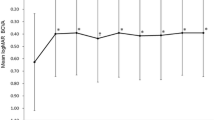Abstract
Background
The objective was to describe the remodeling of the vascular channels in stage II retinal angiomatous proliferation (RAP) treated by intravitreal injections of triamcinolone acetonide (TA) and subsequent photodynamic therapy (PDT).
Methods
Stage II RAP secondary to age-related macular degeneration was documented by dynamic digital fluorescein and indocyanine green angiography in 3 consecutive patients (3 eyes). All eyes were treated with intravitreal injection of TA (4 mg, 0.1 ml) followed by PDT 5–10 days later.
Results
Indocyanine green angiography (ICGA) revealed a complete remodeling of the vascular structure of the three RAPs after treatment. The feeding retinal artery, which shunted a major part of the blood flow from the original arteriole toward the intraretinal neovascular complex before treatment, regained a normal appearance after treatment. With RAP closure, the blood flow was again directed through the original retinal arteriole, and the connection to the RAP was no longer visible.
Conclusions
Stage II RAPs are difficult lesions to treat. A real remodeling of the vascular lesion is achieved with the combined use of intravitreal TA and PDT. This finding corroborates the need for randomized clinical trials currently under way to evaluate this combination treatment in wet, age-related macular degeneration.



Similar content being viewed by others
References
Bandi N, Kompella UB (2001) Budesonide reduces vascular endothelial growth factor secretion and expression in airway (Calu-1) and alveolar (A549) epithelial cells. Eur J Pharmacol 425:109–116
Boscia F, Furino C, Sborgia L, Reibaldi M, Sborgia C (2004) Photodynamic therapy for retinal angiomatous proliferations and pigment epithelium detachment. Am J Ophthalmol 138:1077–1079
Bottoni F, Massacesi A, Cigada M, Viola F, Musico I, Staurenghi G (2005) Treatment of retinal angiomatous proliferation in age-related macular degeneration. A series of 104 cases of retinal angiomatous proliferation. Arch Ophthalmol 123:1644–1650
Ciulla TA, Criswell MH, Danis RP, Hill TE (2001) Intravitreal triamcinolone acetonide inhibits choroidal neovascularization in a laser-treated rat model. Arch Ophthalmol 119:399–404
Folkman J, Ingber DE (1987) Angiostatic steroids. Method of discovery and mechanism of action. Ann Surg 206:374–383
Gillies MC, Simpson JM, Luo W, Penfold P, Hunyor ABL, Chua W, Mitchell P, Billson F (2003) A randomized clinical trial of a single dose of intravitreal triamcinolone acetonide for neovascular age-related macular degeneration: one-year results. Arch Ophthalmol 121:667–673
Grisanti S, Tatar O, Petermeier K, Lafaut BA, Gelisken F, Inhoffen W, Bartz-Schmidt KU (2004) Immunohistopathologic evaluation of choroidal neovascular membranes following verteporfin-photodynamic therapy. Paper presented at: Club Jules Gonin XXIVth Meeting Athens, Greece, 12 September
Nauck M, Karakiulakis G, Perruchoud AP, Papakonstantinou E, Roth M (1998) Corticosteroids inhibit the expression of the vascular endothelial growth factor gene in human vascular smooth muscle cells. Eur J Pharmacol 341:309–315
Penfold PL, Wen L, Madigan MC, Gillies MC, King NJ, Provis JM (2000) Triamcinolone acetonide modulates permeability and intercellular adhesion molecule-1 (ICAM-1) expression of the ECV304 cell line: implications for macular degeneration. Clin Exp Immunol 121:458–465
Penfold PL, Wong JG, Gyory J, Billson FA (2001) Effects of triamcinolone acetonide on microglial morphology and quantitative expression of MHC-II in exudative age-related macular degeneration. Clin Exp Ophthalmol 29:188–192
Schmidt-Erfurth U, Schlotzer-Schrehard U, Cursiefen C et al (2003) Influence of photodynamic therapy on expression of vascular endothelial growth factor (VEGF), VEGF receptor 3 and pigment epithelium-derived factor. Invest Ophthalmol Vis Sci 44:4473–4480
Wang YS, Friedrichs U, Eichler W, Hoffmann S, Wiedemann P (2002) Inhibitory effects of triamcinolone acetonide on bFGF-induced migration and tube formation in choroidal microvascular endothelial cells. Graefes Arch Clin Exp Ophthalmol 240:42–48
Author information
Authors and Affiliations
Corresponding author
Rights and permissions
About this article
Cite this article
Bottoni, F., Romano, M., Massacesi, A. et al. Remodeling of the vascular channels in retinal angiomatous proliferations treated with intravitreal triamcinolone acetonide and photodynamic therapy. Graefe's Arch Clin Exp Ophthalmo 244, 1528–1533 (2006). https://doi.org/10.1007/s00417-006-0311-9
Received:
Revised:
Accepted:
Published:
Issue Date:
DOI: https://doi.org/10.1007/s00417-006-0311-9




